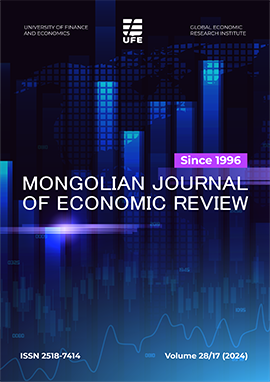Evaluating the meat market integration in the capital city and rural areas
DOI:
https://doi.org/10.69588/mjer.v28i17.3483Keywords:
Spatial market integration, meat market, Ravallion’s testAbstract
In 2018, our country earned MNT 400.0 billion from meat export, which it has reached the highest level in history. However, the price of meat increased due to decrease in the supply of meat in the markets of Ulaanbaatar city (capital city of Mongolia) then the government took measures to limit the export of meat. This study determines the degree of integration between the central market (or Ulaanbaatar) and the local meat market. To assess the market integration, we estimate the Ravallion's test based on a dynamic regression model using monthly beef price data. The test estimates separately the integration of two markets in the short term (in the form of strong and weak internals) and in the long term. As a result, the meat market of both Arkhangai, Dornod, and Khentii provinces, which were included in the research, has only long-term integration with the market of Ulaanbaatar city, while Khuvsgul province has no integration. Moreover, the results of Ravallion's test were confirmed by estimating both co-integration model and error-correction model. In response to the increase in the price of meat in Ulaanbaatar, the price of meat in Khentii province increases the most scale, while market prices in Dornod province respond faster than the other three provinces. The policy recommendations from the results are: First, the fact that the meat markets of the capital and local areas have not been integrated in a short period of time indicates that the market is not working efficiently. Secondly, one of the ways to not increase the price of meat in Ulaanbaatar city along with the increase of meat export is to prepare the meat for export from provinces far away from Ulaanbaatar, whose markets are not integrated
Нийслэл, орон нутгийн махны зах зээлийн интеграцийг үнэлэх нь
Манай улс 2018 онд махны экспортоос 400,0 тэрбум төгрөгийн орлого олж, түүхэн дээд түвшин хүрсэн байдаг. Гэтэл Улаанбаатар хотын хүнсний захуудад нийлүүлэлт буурснаар махны үнэ өсч, засгийн газраас махны экспортыг хязгаарлах хариу арга хэмжээ авсан юм. Энэхүү судалгааны ажлаар Улаанбаатар ба орон нутгийн махны зах зээлийн хоорондох интеграц хэр хэмжээнд байгааг тодорхойлов. Бид үхрийн махны сарын үнийн мэдээлэл ашиглан динамик регрессийн загварт тулгуурласан Ravallion-ий тестээр зах зээлийн интеграцийг шалгав. Уг тест нь хоёр зах зээлийн интеграцийг богино хугацаа (дотроо хүчтэй ба сул гэсэн хэлбэртэй) болон урт хугацаагаар үнэлгээ өгдөг. Улмаар судалгаанд хамрагдсан Архангай, Дорнод, Хэнтий аймгуудын махны зах зээл Улаанбаатар хотын зах зээлтэй зөвхөн урт хугацааны интеграцтай, харин Хөвсгөл аймаг интеграцгүй байгааг тогтоов. Мөн урт хугацааны хамаарал (co-integration), алдаа-засварлах загвар (ECM)-ыг давхар үнэлэхэд Ravallion-ий тестийн үр дүнг бататгав. Тухайлбал, Улаанбаатар хотын махны үнийн өсөлтийн хариуд Хэнтий аймагт махны үнэ хамгийн ихээр өсдөг бол Дорнод аймгийн зах зээлийн үнэ бусад гурван аймагтай харьцуулахад хурдан хариу үзүүлдэг байна. Судалгааны үр дүнгээс гарах бодлогын санал, дүгнэлт нь: Нэгт, Нийслэл, орон нутгийн махны зах зээл богино хугацаанд интеграцлагдаагүй байгаа нь тэр хэрээр зах зээл үр ашигтай ажиллахгүй байгааг харуулж байна. Хоёрт, Махны экспортыг нэмэгдүүлэхтэй хамт Улаанбаатар хотын махны үнийг өсгөхгүй байх нэг арга зам нь экспортын мах бэлтгэлийг Улаанбаатар хотоос алслагдсан, зах зээл нь интеграцлагдаагүй аймгуудаас бүрдүүлэх, энэ чиглэлийн зах зээл, зохицуулалтыг шинээр бий болгох явдал юм.
Түлхүүр үг:
Бүс нутгийн зах зээлийн интеграц, махны зах зээл, Ravallion-ий тест
Downloads
267
References
Alderman, H. (1992). Intercommodity price transmittal: Analysis of food markets in Ghana. World Bank Publications. https://doi.org/10.1111/j.1468-0084.1993.mp55001003.x
Benson, B., Faminow, M., & Fik, T. (1992). Conduct in spatial markets: an empirical analysis of spatial pricing behavior. Papers in Regional Science, 71(1), 15-30. https://doi.org/10.1111/j.1435-5597.1992.tb01745.x
Fackler, P., & Goodwin, B. (2001). Spatial price analysis. Handbook of agricultural economics. https://doi.org/10.1016/S1574-0072(01)10025-3
Jones, W. (1968). The Structure of staple food marketing in Nigeria as revealed by price analysis. Food Research Institute Studie, 8, 95-123.
Jordan, K., & VanSickle, J. (1995). Integration and behavior in the US winter market for fresh tomatoes. Journal of Agricultural and Applied Economics, 27(1), 127-137. https://doi.org/10.1017/S1074070800019672
Lele, U. (1967). Market integration: A study of sorghum prices in western India. American Journal of Agricultural Economics, 49(1), 147-159. https://doi.org/10.2307/1237074
Lutz, C., Tilburg, A., & Kamp, B. (1995). The Process of short-and long-term price integration in the Benin maize market. European review of agricultural Economics, 22(2), 191-212. https://doi.org/10.1093/erae/22.2.191
Mendoza, M., & Rosegrant, M. (1995). Pricing behavior in Philippine corn markets: Implications for market efficiency. Intl Food Policy Res Inst.
Ravallion, M. (1986). Testing market integration. American Journal of Agricultural Economics, 68(1), 102-109. https://doi.org/10.2307/1241654
Downloads
Published
How to Cite
Issue
Section
License
Copyright (c) 2024 Dagiimaa Tuvshinjargal, Tserendorj Batsukh

This work is licensed under a Creative Commons Attribution-NonCommercial-NoDerivatives 4.0 International License.
Copyright on any research article in the Mongolian Geoscientist is retained by the author(s).
The authors grant the Mongolian Journal of Economic Review a license to publish the article and identify itself as the original publisher.

Articles in the Mongolian Journal of Economic Review are Open Access articles published under a Creative Commons ATTRIBUTION-NONCOMMERCIAL-NODERIVS 4.0 INTERNATIONAL - CC BY-NC-ND 4.0.
This license permits use, distribution and reproduction in any medium, provided the original work is properly cited.




